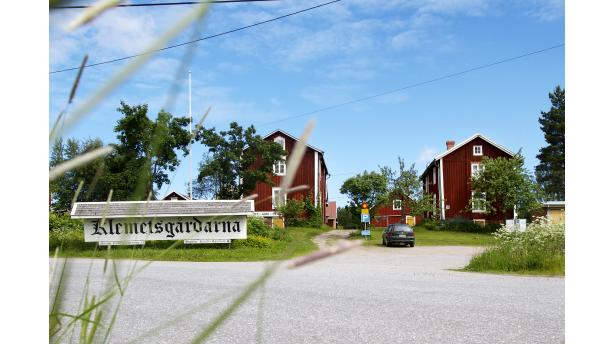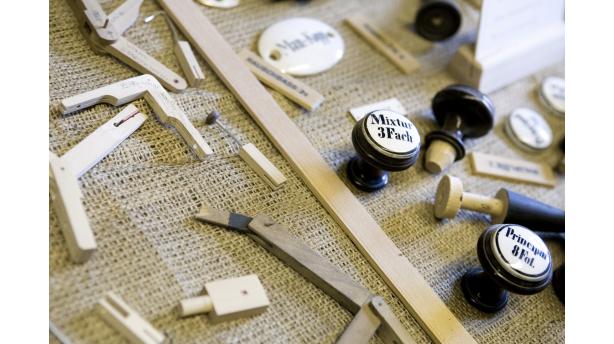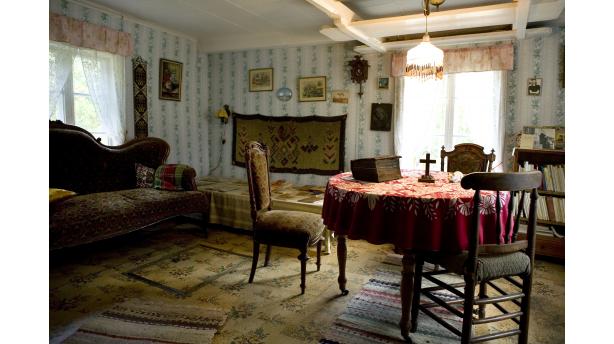Museum A-Ö » Special museum » Klemets Houses
Klemets Houses
- Rural life and craft
- Religion and society
- Nature and garden
- Wars and wartime
- The archipelago, fishing and seafaring
- Special museum



Did you know...
Womens’ petticoats were called stone foundations (in Swedish steinfoten), when there was older fabric in the lower part and newer in the upper part.
The idyllic courtyard milieu of the Klemets Houses is in many ways unique. No other group of houses built in a similar way has survived in the county. Here can as well be found a versatile selection of exhibitions, such as a textile exhibition, a harmonium museum, a motorcycle exhibition and everyday items associated with peasant life. The atmosphere of the early 20th century can also be sensed in the café, which has been elegantly furnished with 1940s functionalism style furniture.
The idyllic courtyard milieu of the Klemets Houses is unique in a number of ways. No other group of houses built in a similar way has survived in the country. Here can as well be found a versatile selection of exhibitions, such as a textile exhibition, a harmonium museum, a Sunday school museum and everyday items associated with peasant life. The atmosphere of the early 20th century can also be sensed in the café, which has been elegantly furnished with 1940s functionalism style furniture.The history of the Klemets Houses reaches all the way to the 18th century. Many people escaped from the Greater Wrath in the beginning of the 18th century and the Klemets estate was deserted. Johan Ehrsson from the Västerbotten Bjurs parish bought the desolate estate and became the progenitor of Klemets with his 23 children. He and his sons built three west Ostrobothnian style houses. They were higher and narrower than Ostrobothnian houses. The eldest of the houses dates back to the 1730s and the others were built between the years 1730 and 1760.
One of the pearls of the museum is an extensive textile exhibition, which comprises various hats, garments, bedlinens and tapestries from the beginning of the 20th century. In the collection are also so called veipor bottom sheets that have been sewn together, which were typical for Swedish-speaking Ostrobothnia. The looms were seldom as wide as the beds and therefore the sheets were sewn together in order to achieve the correct width. The textiles are warm-toned, because they were dyed with plant colours obtained from nature. Here can also be seen baby carriages from the 1920s and 1950s as well as dolls.
The Strömmer foundation is the new supplement of the Klemets hill. The foundation and its rules were registered on the 17th of January in 2015. The purpose of the foundation is to advance different types of cultural and social activity, as well as to supervise the culturohistorically valuable buildings of the Klemets Houses left as legacies, to maintain them in good state and in addition to administer the forest and farming grounds of the foundation.
A short distance from the hill along Kärklaxvägen is a Sunday School Museum, where Svanhild Petrolaj held Sunday school for the children of the village in the beginning of the 20th century. She was from a Polish family and her father worked as the Customs superintendent, but both of her parents died young. Svanhild moved to Maxmo to work as a governess for her cousins, the children of a priest. Svanhild ran a Sunday school in her cabin. She sewed sitting pillows for the children and after twelve o’clock each of the children received a caramel. The priest Daniel Orädd had earlier worked as a seaman clergy in Antwerpen and helped sailors, who had indulged in drinking, to the shelters of the church. Some of the furniture in the cabin, and for instance the radio, originate from Antwerpen from that period. Svanhild didn’t want to follow the ministerial family, when they moved to Helsinki in the 1930s, so the priest Orädd bought her a small cabin. Svanhild worked in the telephone switchboard, but also as a deaconess for the elderly women of the village still in her old days. The graduation ceremony of the Sunday school is held in the cabin even today. The Sunday School Museum is open upon request.
There is also a fishing museum in the archipelago, which is open upon request.


